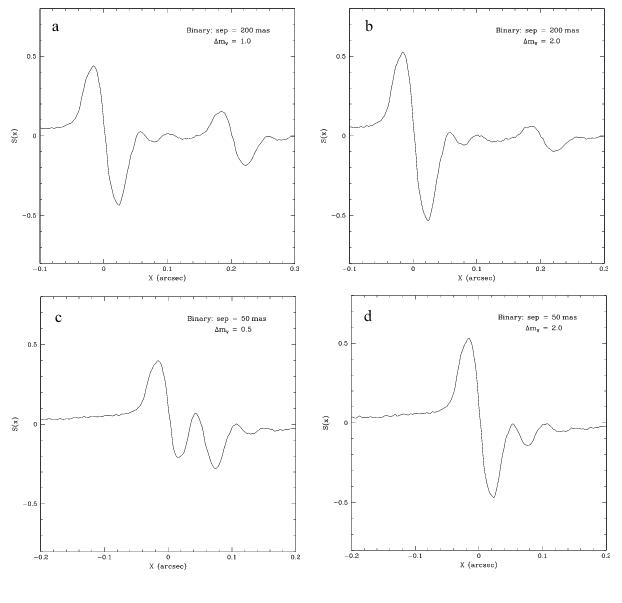4.4 Transfer Mode Overview
4.4.1 The FGS Response to a Binary
If the source is a double star, then its wavefront has two components, each incoherent with respect to the other. Two propagation vectors characterize this wavefront and the angle between them is directly related to the angular separation of the stars on the sky. As the FGS’s IFOV scans across the object, each component of the wavefront can be thought of as generating its own interferogram (or “S-Curve”), whose modulation is diminished by the non-interfering “background” contributed by the other component. The resulting relationship between the position of the IFOV to the normalized difference of the PMTs depends on the separation of the stars and their relative brightnesses. The composite interferogram of a multiple system is the linear superposition of the fringes from the individual components, scaled by their relative brightness and shifted with respect to one another by their separation on the sky. Given this, the fringe pattern of a binary system, whose components have an angular separation α (as projected along the X-axis) and fluxes fa and fb is given by
| S_{binary}(x)l_1S_{single}\ S_{binary}(x)l_2S_{single}=+(x+\alpha)~, |
where:
| l_1=\frac{f_a}{f_{a}+f_b}~~\\ \\ l_2=\frac{f_b}{f_{a}+f_b}~. |
Figure 4.3 shows the changes in the observed FGS1r interferogram due to binary systems of varied separations and magnitude differences. In Figure 4.3a we display the interferogram of a wide binary pair with component separations and magnitude differences of (200 mas, 1.0) respectively. Figure 4.3b is an example of a system with the same separation, but with a magnitude difference of Δm = 2.0. The binary system in Figure 4.3c has a smaller separation and magnitude difference (50 mas and 0.5 respectively), while in Figure 4.3d increases the magnitude difference to Δm = 2.0 for a component separation of 50 mas.
If the angular separation of the stars is greater than the width of the S-Curve, two distinct S-Curves are apparent, but the modulation of each will be diminished relative to that of a single star by an amount depending on the relative flux from each star (see Figure 4.3a and also Figure 3.1). On the other hand, if the angular separation is small, the S-Curves will be superimposed, and the morphology of the resulting blend complicated (as in Figure 4.3d). In either case, the composite S-Curve can be deconvolved using reference S-Curves from point sources, provided the angular separations are not too small and the magnitude difference is not too large. To be more precise, fitting the observed double star S-Curve with two appropriately weighted, linearly superimposed reference S-Curves from single stars leads to the determination of the angular separation, position angle, and magnitude difference of the binary’s components. The modulation, morphology, and temporal stability of the point-source calibration S-Curves determine the resolving power of the FGS. For FGS1r, this is about 7 mas for Δm < 1.0.
4.4.2 The Transfer Mode Exposure
Rather than tracking the fringe as in Position mode observation, the IFOV is scanned across the object along a 45 degree path (with respect to the FGS detector axes) in a Transfer mode exposure. Every 25 milliseconds, star selector angles and data from the four PMTs are recorded. From these data, the fringes of the object can be reconstructed. The number of scans and the length of each scan are derived from the Phase II proposal.
For each target, the step size and scan length must be adjusted as necessary to accomplish the goals of the observation:
- Step Size: The step-size refers to the angular distance covered by the IFOV along an axis during a 25 millisecond interval. The default step-size is 1.0 mas. Higher resolution is achievable using step sizes as fine as 0.3 mas. However, such a small step size may prohibitively increase the total time to complete a scan, and as a result of least significant bit (LSB) constraints and vehicle jitter, the effective resolution may not be better than 1.0 mas. The goal is to execute as many scans as possible, with the smallest StepSize (0.6 or 1.0 mas), to achieve the highest S/N ratio.
- Scan Length: The required scan length is depends on the geometry of the target. A minimum of scan length of 0.3" is needed to fully sample the fringes of a point source along with a sufficient segment of the wings to either side. For binary systems, the scan length should be at least as wide as the component separation plus 0.3".
The point-source calibration S-Curves are obtained only at the center of the FGS1r FOV. Other locations in the FOV are not routinely calibrated. |
